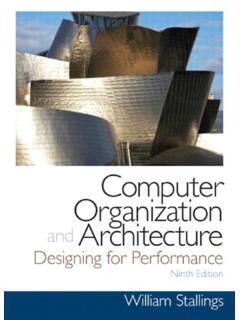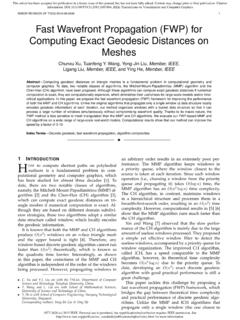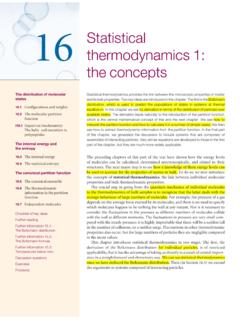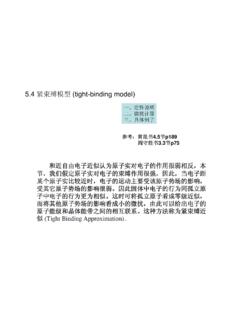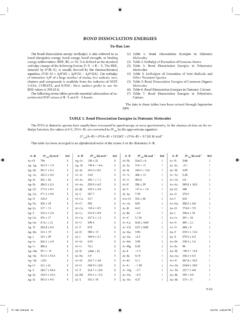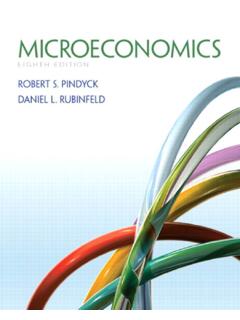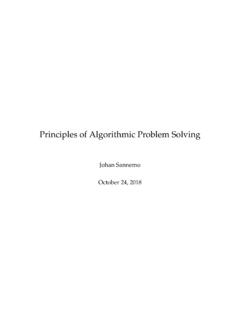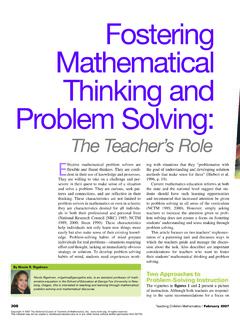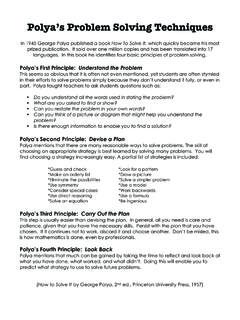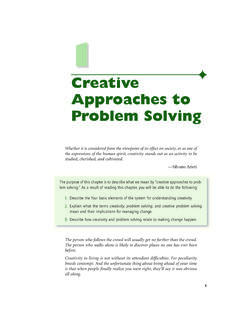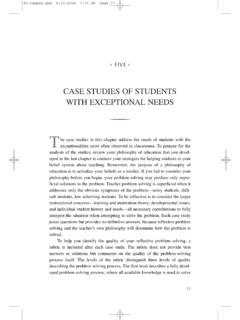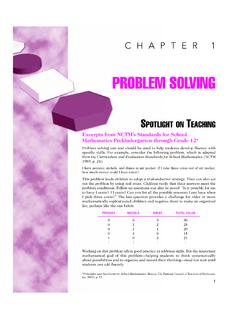Transcription of The Role of Statistics in Engineering - USTC
1 1 The Role of Statisticsin EngineeringCHAPTER OUTLINE1 LEARNING OBJECTIVESA fter careful study of this chapter you should be able to do the following:1. Identify the role that Statistics can play in the Engineering problem-solving process2. Discuss how variability affects the data collected and used for making Engineering decisions3. Explain the difference between enumerative and analytical studies4. Discuss the different methods that engineers use to collect data5. Identify the advantages that designed experiments have in comparison to other methods of col-lecting Engineering data6. Explain the differences between mechanistic models and empirical models7. Discuss how probability and probability models are used in Engineering and scienceCD MATERIAL8. Explain the factorial experimental Explain how factors can for most odd numbered exercises are at the end of the book. Answers to exercises whosenumbers are surrounded by a box can be accessed in the e-Text by clicking on the box.
2 Completeworked solutions to certain exercises are also available in the e-Text. These are indicated in theAnswers to Selected Exercises section by a box around the exercise number. Exercises are also1-1 THE Engineering METHOD ANDSTATISTICAL THINKING1-2 COLLECTING Engineering Basic Retrospective Observational Designed A Factorial Experiment for the Pull-off Force Problem (CD Only) Observing Processes Over Time 1-3 MECHANISTIC AND EMPIRICALMODELS1-4 PROBABILITY AND 5/9/02 1:27 PM Page 1 RK UL 6 RK UL 6:Desktop Folder:TEMP WORK:MONTGOMERY:REVISES UPLO D CH112 FIN L:2 CHAPTER 1 THE ROLE OF Statistics IN Engineering available for some of the text sections that appear on CD only. These exercises may be found withinthe e-Text immediately following the section they THE Engineering METHOD AND STATISTICAL THINKINGAn engineer is someone who solves problems of interest to society by the efficient applicationof scientific principles.
3 Engineers accomplish this by either refining an existing product orprocess or by designing a new product or process that meets customers needs. The Engineering ,or scientific, methodis the approach to formulating and solving these problems. The steps inthe Engineering method are as a clear and concise description of the , at least tentatively, the important factors that affect this problem or that mayplay a role in its a model for the problem, using scientific or Engineering knowledge of thephenomenon being studied. State any limitations or assumptions of the appropriate experiments and collect data to test or validate the tentativemodel or conclusions made in steps 2 and the model on the basis of the observed the model to assist in developing a solution to the an appropriate experiment to confirm that the proposed solution to the prob -lem is both effective and conclusions or make recommendations based on the problem steps in the Engineering method are shown in Fig.
4 1-1. Notice that the Engineering methodfeatures a strong interplay between the problem, the factors that may influence its solution, amodel of the phenomenon, and experimentation to verify the adequacy of the model and theproposed solution to the problem. Steps 2 4 in Fig. 1-1 are enclosed in a box, indicating thatseveral cycles or iterations of these steps may be required to obtain the final , engineers must know how to efficiently plan experiments, collect data, analyzeand interpret the data, and understand how the observed data are related to the model theyhave proposed for the problem under field of statisticsdeals with the collection, presentation, analysis, and use of data tomake decisions, solve problems, and design products and processes. Because many aspects ofengineering practice involve working with data, obviously some knowledge of Statistics isimportant to any engineer.
5 Specifically, statistical techniques can be a powerful aid in design-ing new products and systems, improving existing designs, and designing, developing, andimproving production 1-1 Theengineering acleardescriptionIdentify theimportantfactorsPropose orrefine amodel 5/9/02 1:27 PM Page 2 RK UL 6 RK UL 6:Desktop Folder:TEMP WORK:MONTGOMERY:REVISES UPLO D CH112 FIN L:1-1 THE Engineering METHOD AND STATISTICAL THINKING3 Statistical methods are used to help us describe and understand variability,we mean that successive observations of a system or phenomenon do not produce exactly thesame result. We all encounter variability in our everyday lives, and statistical thinkingcangive us a useful way to incorporate this variability into our decision-making processes. Forexample, consider the gasoline mileage performance of your car. Do you always get exactly thesame mileage performance on every tank of fuel?
6 Of course not in fact, sometimes the mileageperformance varies considerably. This observed variability in gasoline mileage depends onmany factors, such as the type of driving that has occurred most recently (city versus highway),the changes in condition of the vehicle over time (which could include factors such as tireinflation, engine compression, or valve wear), the brand and/or octane number of the gasolineused, or possibly even the weather conditions that have been recently experienced. These factorsrepresent potential sources of variabilityin the system. Statistics gives us a framework fordescribing this variability and for learning about which potential sources of variability are themost important or which have the greatest impact on the gasoline mileage also encounter variability in dealing with Engineering problems. For example, sup-pose that an engineer is designing a nylon connector to be used in an automotive engineapplication.
7 The engineer is considering establishing the design specification on wall thick-ness at 3 32 inch but is somewhat uncertain about the effect of this decision on the connectorpull-off force. If the pull-off force is too low, the connector may fail when it is installed in anengine. Eight prototype units are produced and their pull-off forces measured, resulting in thefollowing data (in pounds): , , , , , , , As we anticipated,not all of the prototypes have the same pull-off force. We say that there is variability in thepull-off force measurements. Because the pull-off force measurements exhibit variability, weconsider the pull-off force to be a random convenient way to think of a randomvariable, say X, that represents a measurement, is by using the model(1-1)where is a constant and is a random disturbance. The constant remains the same with everymeasurement, but small changes in the environment, test equipment, differences in the indi-vidual parts themselves, and so forth change the value of.
8 If there were no disturbances, would always equal zero and Xwould always be equal to the constant . However, this neverhappens in the real world, so the actual measurements Xexhibit variability. We often need todescribe, quantify and ultimately reduce 1-2 presents a dot diagramof these data. The dot diagram is a very useful plot fordisplaying a small body of data say, up to about 20 observations. This plot allows us to see eas-ily two features of the data; the location,or the middle, and the scatteror thenumber of observations is small, it is usually difficult to identify any specific patterns in the vari-ability, although the dot diagram is a convenient way to see any unusual data need for statistical thinking arises often in the solution of Engineering the engineer designing the connector. From testing the prototypes, he knows that theaverage pull-off force is pounds.
9 However, he thinks that this may be too low for theX 12141315 Pull-off forceFigure 1-2 Dot diagram of the pull-off forcedata when wall thickness is 3/32 force332inchinch=18=Figure 1-3 Dot diagram of pull-off force for two 5/9/02 1:28 PM Page 3 RK UL 6 RK UL 6:Desktop Folder:TEMP WORK:MONTGOMERY:REVISES UPLO D CH112 FIN L:4 CHAPTER 1 THE ROLE OF Statistics IN ENGINEERINGF igure 1-5 Enumerative versus analytic , x2, .., xn x1, x2, .., xn intended application, so he decides to consider an alternative design with a greater wallthickness, 1 8 inch. Eight prototypes of this design are built, and the observed pull-off forcemeasurements are , , , , , , , and The average is for both samples are plotted as dot diagrams in Fig. 1-3, page 3. This display givesthe impression that increasing the wall thickness has led to an increase in pull-off , there are some obvious questions to ask.
10 For instance, how do we know that an-other sample of prototypes will not give different results? Is a sample of eight prototypesadequate to give reliable results? If we use the test results obtained so far to conclude thatincreasing the wall thickness increases the strength, what risks are associated with this de-cision? For example, is it possible that the apparent increase in pull-off force observed inthe thicker prototypes is only due to the inherent variability in the system and that increas-ing the thickness of the part (and its cost) really has no effect on the pull-off force?Often, physical laws (such as Ohm s law and the ideal gas law) are applied to help designproducts and processes. We are familiar with this reasoning from general laws to specificcases. But it is also important to reason from a specific set of measurements to more generalcases to answer the previous questions.
